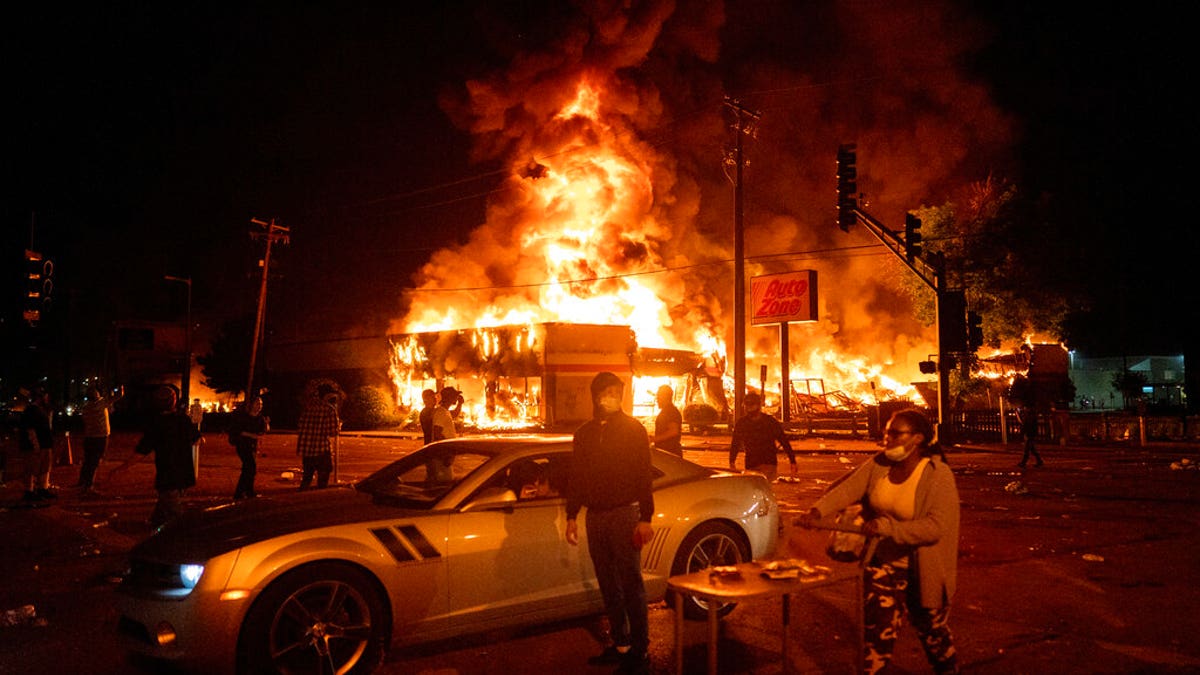Police and law enforcement used force against protesters in at least 125 separate incidents across the country in the 10 days following the death of George Floyd, a new watchdog report revealed on Monday.
The report, "The World is Watching: Mass Violations by US Police of Black Lives Matter Protesters’ Rights" by human rights organization Amnesty International, says that between May 26 and June 5, there were at least six incidents of police using batons, and 13 instances of the use of projectiles such as sponge rounds and rubber bullets in 13 cities across the U.S.
AURORA POLICE APOLOGIZE AFTER DRAWING GUNS, HANDCUFFING BLACK FAMILY IN CAR THEFT MIX-UP

Demonstrators shield themselves from tear gas launched over a fence by federal officers during a Black Lives Matter protest at the Mark O. Hatfield United States Courthouse on Friday, July 24, 2020, in Portland, Ore. (AP Photo/Marcio Jose Sanchez)
The incidents occurred as hundreds of people took to the streets decrying police brutality, particularly against minorities, after Floyd, an unarmed black man, died while being detained by Minneapolis police on May 25.
His death was the catalyst for repeated calls to defund police and to address disproportionate use of force against minorities by law enforcement.
Clashes have erupted around the country between law enforcement and protesters as peaceful demonstrations in some cities turned violent, with rioting, burning of buildings and attacks on police.

Police say a man captured on surveillance video breaking windows at a south Minneapolis auto parts store in the days after George Floyd’s death is a Hell’s Angels member who was bent on stirring up social unrest. (Mark Vancleave/Star Tribune via AP)
Amnesty International reported that police used "unnecessary" tear gas and pepper spray "as a first resort to disperse large groups of peaceful protestors." The group documented 89 cases of specific use of tear gas in cities in 34 states and 21 incidents of unlawful use of pepper spray in 15 states and the District of Columbia.
"Such unnecessary and excessive tactics were also used by law enforcement to target medics, legal observers and media representatives," the group said.
In July, President Trump sent hundreds of federal officers into cities such as Washington, D.C., and Portland, Ore., under the guise of protecting federal property, a move that exacerbated an already volatile situation in some areas.
The Department of Justice is now probing the use of force by those federal law enforcement agents, who have been accused of obscuring their identities and failing to identify themselves as officers while making unexplained arrests and detaining protesters without reason.
"The response to the protesters by police in many cities was to confront them wearing riot gear (helmets and vests) and carrying shields and batons as a first level of response, rather than in response to any particular act of violence," the report said. "Some were armed with semi-automatic rifles and some had police dogs."

Philonise Floyd, brother of George Floyd, second from right, gestures as he addresses a crowd in front of the statue of Confederate General Robert E. Lee on Monument Avenue on Tuesday July 28, 2020, in Richmond, Va. (AP Photo/Steve Helber)
"Officers moved among the protesters using armored vehicles more appropriate for a conflict zone than the streets of U.S. cities and towns. Amnesty International has verified hundreds of videos of police in military-grade equipment being deployed during the protests."
In the initial weeks of the protest, at least 600 police officers were injured during looting and rioting that occurred as offshoots of the demonstrations.
Between the date of Floyd's death and June 11, at least 132 officers were hurt in Chicago during a riot, at least 50 Secret Service Agents were injured by Molotov cocktails thrown at them in Washington, D.C., and more than 350 New York police officers were wounded.
An additional 96 officers were either assaulted or attacked during the first two weeks of protests.
A Federal Protective Service officer was killed by an active shooter in Oakland, Calif., and his sister appealed to federal lawmakers following his death in June to end violence against police during the tumultuous period.
A retired St. Louis Police captain who was acting as a private security guard at a pawn shop was also shot and killed by looters.
Despite the violence and amplified tensions, thousands of demonstrators have marched peacefully and without incident in their cities, some working together with local law enforcement to strengthen their relationships.
CLICK HERE FOR THE FOX NEWS APP
"Police officials in cities such as Newark, New Jersey; Flint, Michigan; and Camden, New Jersey, met and marched with protesters through their respective cities’ streets," the report said.

